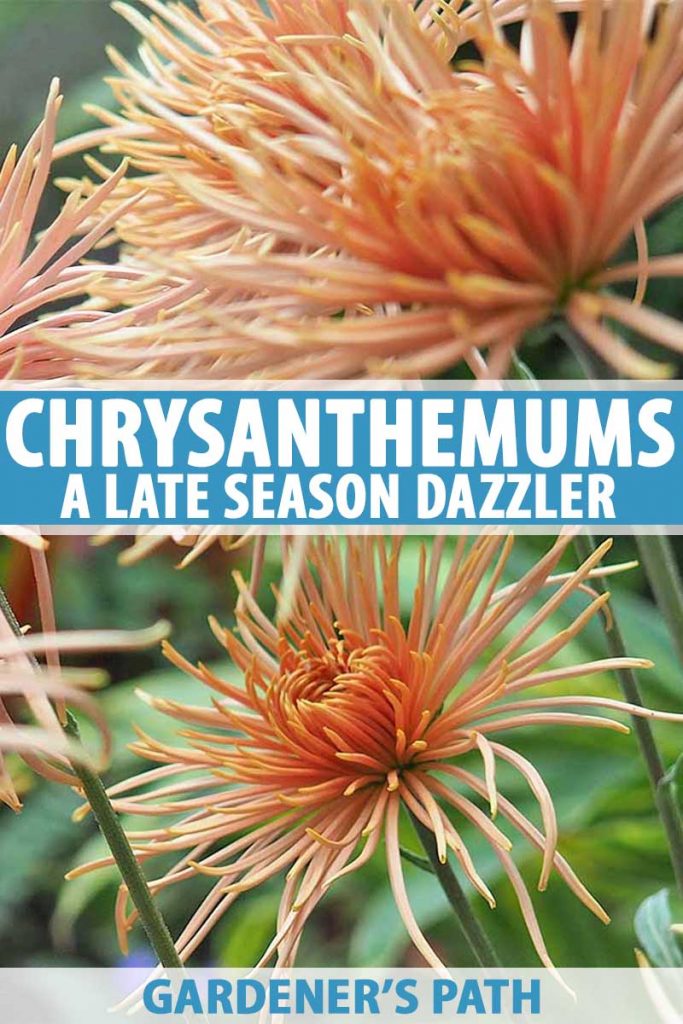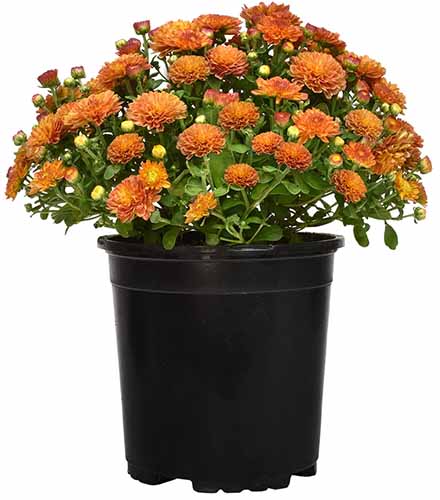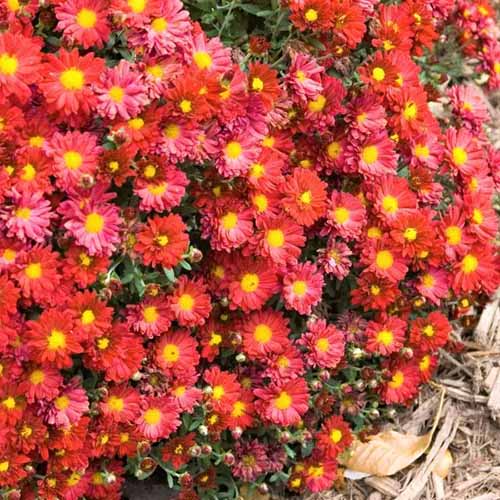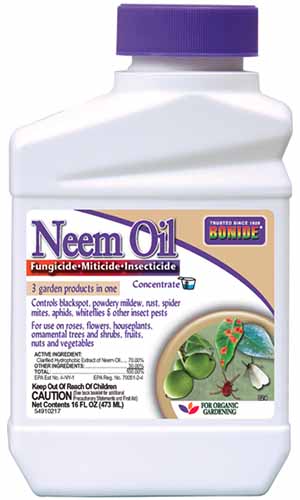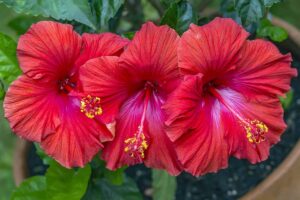Chrysanthemum spp.
Hardy garden chrysanthemums are among the most popular end-of-season flowers, easily grown and reliable ornamentals loaded with brightly colored blooms throughout late summer and fall.
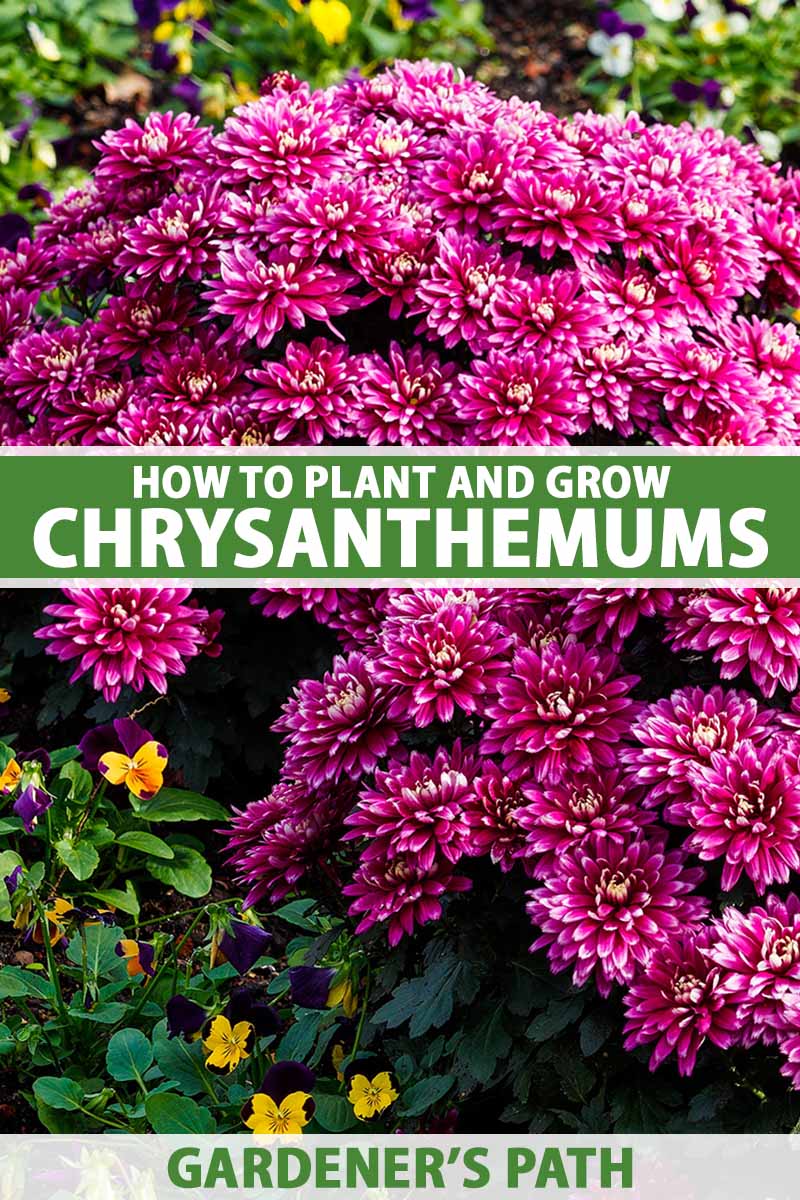
We link to vendors to help you find relevant products. If you buy from one of our links, we may earn a commission.
Numerous showy flower types add beautiful, warm colors in rich shades of mauve, orange, red, purple, white, and yellow to beds, borders, and containers.
And they’re ideal for autumn celebrations in tabletop centerpieces, cornucopia displays, and cut flower arrangements.
With excellent cold hardiness, chrysanthemums shrug off a light touch of frost and colors often deepen and improve with cold weather!
Plus, they attract bees and other garden-friendly insects, but are repellent to nibbling deer and squirrels.
And many gardeners, including me, use chrysanthemums as beneficial companion plants in the veggie patch for their effective pest-busting properties.
Cultivated for millennia, mums are revered in many cultures and steeped in symbolic meaning, with variations depending on the country or region and its customs.
But regardless of where they’re grown, they have a universal appeal when the air turns nippy!
Does your autumn garden need some easy, reliable color? Then it’s time to dig into how to grow chrysanthemums for late season color.
Here’s what you’ll find ahead:
What You’ll Learn
What Are Chrysanthemums?
Chrysanthemum is a large genus in the Asteraceae family.
Cold-hardy herbaceous perennials, mums are closely related to other popular garden flowers such as the aster, cosmos, daisy, dahlia, marigold, sunflower, and zinnia.

Also known as hardy garden mums or simply mums, their forebears came from northeastern Europe and Asia in colors limited to shades of red, white, and yellow.
Today’s hardy garden mums are of hybrid origin, and with over 20,000 known cultivars, there’s now a vast assortment of colors available!
Popular chrysanthemum shades include burgundy, chocolate, lime green, mauve, maroon, orange, peach, pink, purple, salmon, scarlet, white, and yellow, plus bicolors.
Hardy garden mums can withstand cold temperatures and readily overwinter in temperate regions with a little protection – but they shouldn’t be confused with exhibition chrysanthemums.
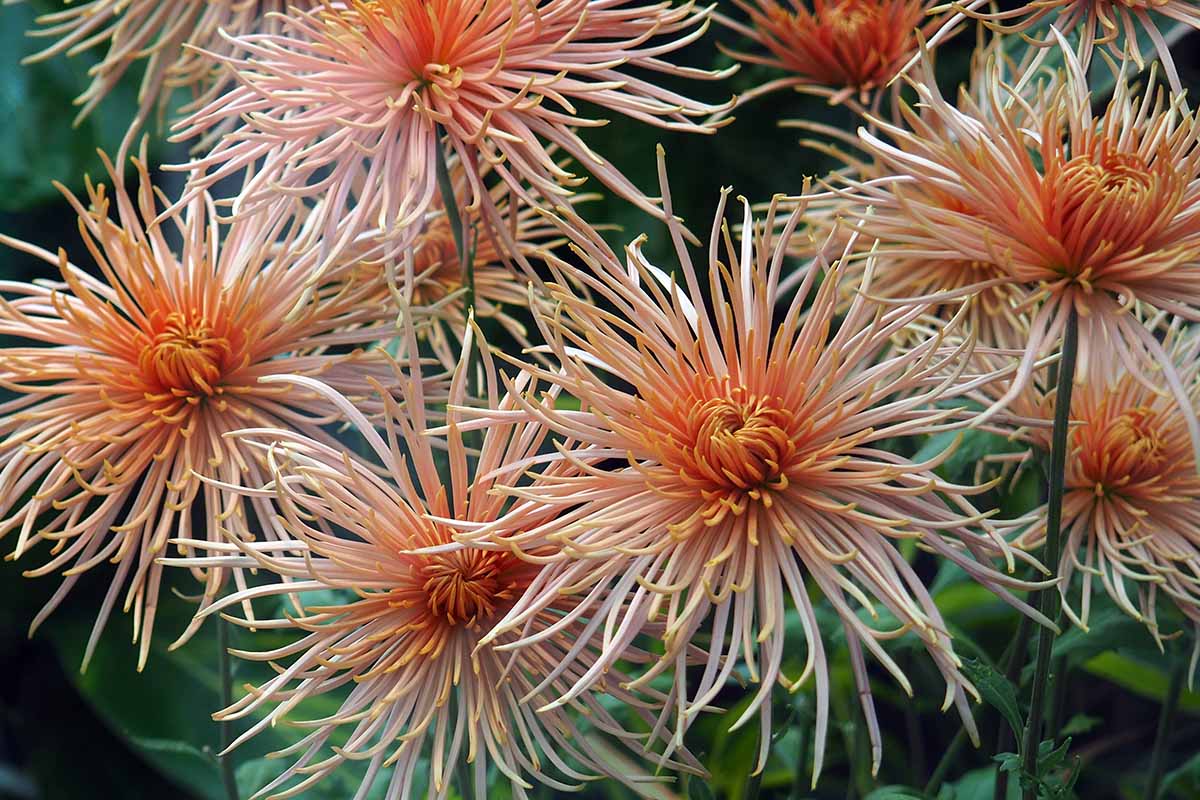
Exhibition or florist chrysanthemums are gorgeous, but delicate.
They aren’t as cold hardy and need a lot of attention, plus a special environment, to produce flowers worthy of garden shows – beautiful, but a lot of work!
If you are interested in growing show flowers, a good place to start is with a reference book – Pat Johnston’s book “Mums the Word: Secrets to Growing Chrysanthemums for Home or Show” has the details and is available at Amazon.

Mums the Word: Secrets to Growing Chrysanthemums for Home or Show
Hardy mums have a handsome, mounding shape of 12 to 36 inches tall and up to 48 inches wide.
These may exhibit several growth habits, including small dwarf varieties as well as larger shrub-sized specimens.
Leaves of dark forest green add a cool base to contrast with the bright flowers. They are arranged alternately on thick, sturdy stems, featuring a lobed shape with serrated or smooth edges.
Flower forms range from daisy-like ray florets to globular pompoms and wispy spider types, with the majority flowering from midsummer to mid-autumn when planted in spring.
I’ll cover more on the various chrysanthemum flower classifications in a bit.
Pruning at the right time is an important aspect of chrysanthemum cultivation as it produces the branching needed for the dense and impressive flowerhead displays they’re known for.
Some newer hybrids, like those in the Mammoth™ series, produce ample flowers without pruning, but most available cultivars benefit from regular pinching or pruning.
Chrysanthemums are also known as good companion plants for the powerful pest repellent compounds they contain. Known as pyrethrins, these are used in pesticides against the likes of ants, fleas, mosquitos, and moths.
To make your own pyrethrum-based insecticide, our guide on how to use chrysanthemums for pest control in the garden has the details.
Garden mums have good cold hardiness, with most varieties suited to USDA Zones 4 to 9, and many fit for Zone 3 growth.
And it should be noted that chrysanthemums are mildly toxic to cats, dogs, and horses.
Cultivation and History
Chrysanthemums have been cultivated for millennia.
First grown and revered by the Chinese, mums made their way to Japan in the late 300s where they were developed, and jealously guarded, for centuries.
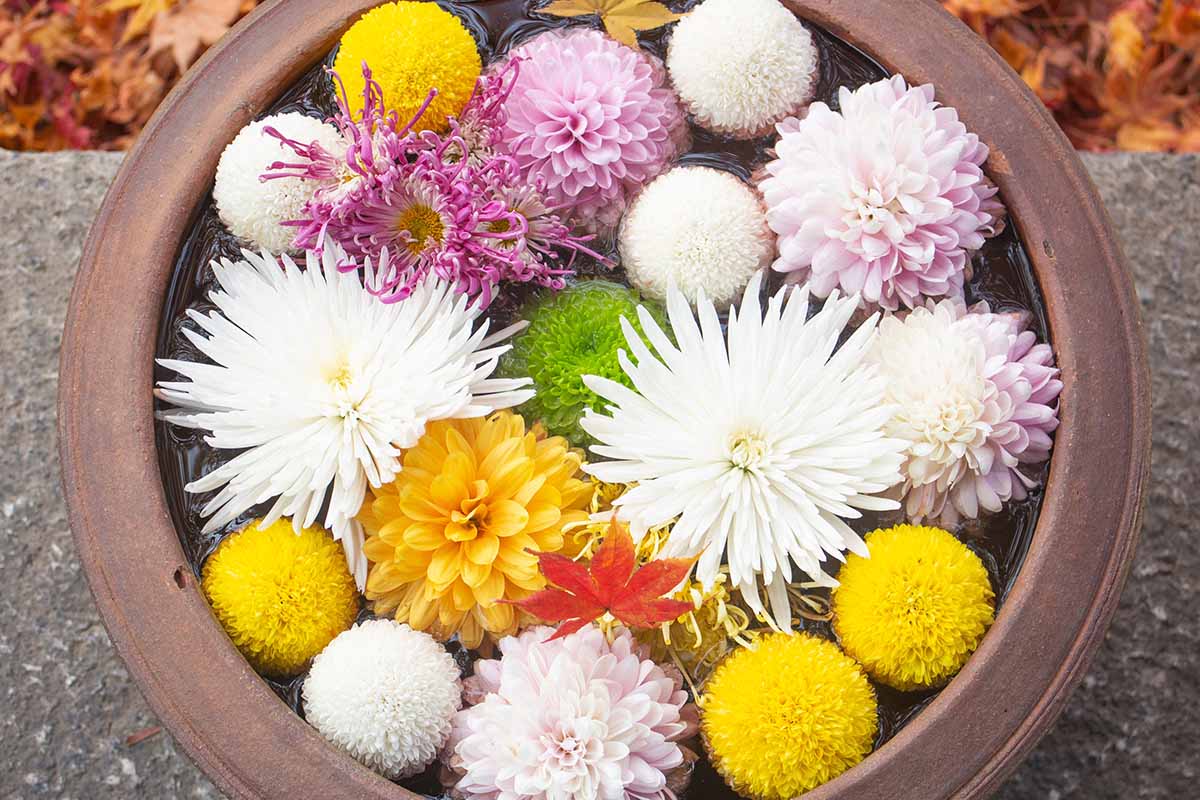
The first chrysanthemum cultivars arrived in Europe in the late 1700s, and in North America before the end of the 18th century.
Swedish botanist Karl Linnaeus named them by compounding the Greek words chrysos (gold) and anthemon (flower) to describe the luminous beauty of their golden flowers.
The garden mum is of hybrid origin, the result of extensive crossbreeding of C. indicum with several other chrysanthemum species.
And its taxonomy has changed many times in the last three hundred years, resulting in numerous synonyms, including C. × grandiflorum and Dendranthema × grandiflorum, the latter after some species were moved into the Dendranthema genus.
However, some growers protested the expulsion and transfer to a new genus.
In 1999, the International Botanical Congress deemed C. indicum to be the type species, moving both the florist and hardy garden mum back into the Chrysanthemum genus.
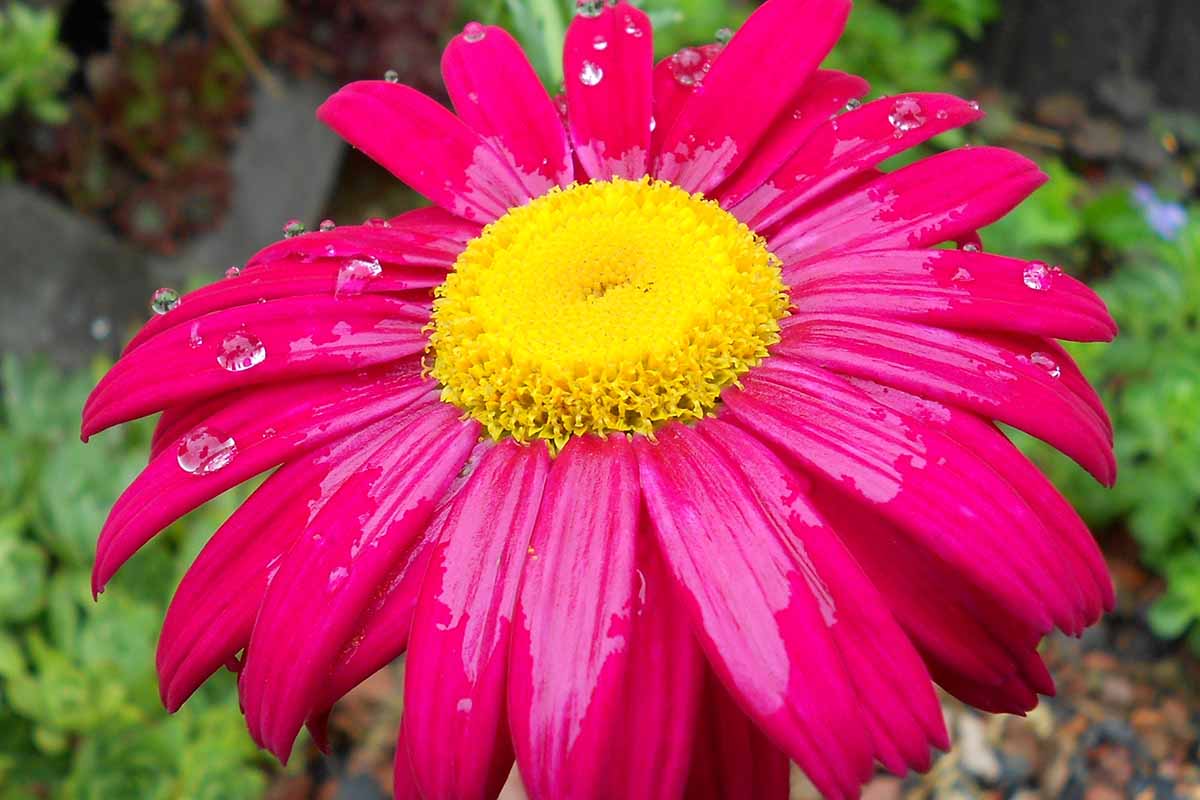
Adding to the mix, varieties of C. x rubellum are also known as hardy mums.
Hardy to Zone 4, these hybrid chrysanthemums form loose clumps two to three feet tall with an open form that can require staking.
Highly responsive to breeding efforts, today there are 13 different chrysanthemum flower classifications.
Here’s a brief look:
- Irregular Incurve (Class 1) – Giant blooms of 6-8 inches with fully closed centers form loose, incurved top petals and a skirt from the lower ones. These are top-heavy plants that need staking.
- Reflex (Class 2) – Medium to large flowers of 4-6 inches in diameter with downward, overlapping petals in a slightly flattened form. Staking required.
- Regular Incurve (Class 3) – Medium to large flowers of 4-6 inches form perfect globes from the tightly folded, incurved petals. Staking required.
- Decorative (Class 4) – The most common class for hardy garden mums with 1-4-inch open florets that are incurved or reflexed and can appear slightly flat.
- Intermediate Incurve (Class 5) – Medium to large flowers of 4-6 inches with partially incurved petals that give a loose but even profile. May need staking.
- Pompom (Class 6) – Small, fully rounded blooms of up to 4 inches with regular incurved petals that cover the center.
- Single/Semi-Double (Class 7) – Open, daisy-like flowers of 2-3 inches with single or semi-double ray florets and a center disc.
- Anemone (Class 8) – Small to large flowers of 2-6 inches with open, ray florets and large, cushion-like center discs. May need staking.
- Spoon (Class 9) – Small to medium flowers of 2-4 inches with furled, spatulate petals with open, ladle-like tips and center discs.
- Quill (Class 10) – Small to medium flowers of 2-6 inches with narrow, tubular petals in single to double florets.
- Spider (Class 11) – Medium to large flowers of 4-6 inches in a loose mass of tight, tubular petals with a hooked tip.
- Brush and Thistle (Class 12) – Small to medium flowers of 2-4 inches with fine, rolled petals in upright or fan forms.
- Unusual/Exotic/Unclassified (Class 13) – Flowers that don’t fit other classes and unique varieties usually reserved for flower shows.
Hardy garden mums also come in two basic forms of spray and single bloom or standard.
Spray chrysanthemum varieties are multibranched and highly floriferous, forming dense mounds with several flower buds per stem.

Single bloom varieties have a loose form and less branching, with one, daisy-like bloom per stem featuring single or semi-double petals, like ‘Clara Curtis.’
Now, let’s look at how to propagate.
Chrysanthemum Propagation
Chrysanthemums are easily propagated through division and by rooting basal or stem cuttings.
Some mum varieties, like tricolor daisies (C. carinatum), are grown as annuals and can be propagated from seed.
But most hardy perennial hybrids are unreliable if grown from seed and don’t produce plants true to their parent.
Divisions
For the lushest plants, mums need division every three to four years or when the center starts to thin out and becomes woody, or bare spots appear.
To divide, use a clean spade to lift plants from garden beds in early spring after new growth emerges.
Insert the spade four to six inches past the foliage and lift the root ball in one piece. For very large plants, use a sharp spade to carefully slice them in half or quarters before lifting.
Use your fingers or a clean, sharp garden knife to gently pull the roots apart or cut into equal sections.
Trim away and discard any central woody parts – these old sections grow much slower, if at all, than pieces with new roots.
Plant divisions into beds or containers as outlined below.
From Basal Cuttings
Basal cuttings should be taken in late winter or early spring after new growth is about four inches tall.
Use a clean, sharp knife to remove several stems from the outside perimeter, cutting close to the crown.
Remove lower leaves from cuttings and dip in a rooting hormone if desired.
Fill four-inch pots with a half-and-half mix of potting soil and compost and insert cuttings up to the first set of leaves, about three per pot, spaced evenly apart.
Water until the soil is moist, but not wet, then cover with a plastic bag or cloche. Ensure bags don’t touch the foliage by supporting them with chopsticks or pencils.
Place in bright, indirect light and keep the soil moist until the cuttings have rooted, in three to four weeks.
After new roots are established, pot up into larger containers or plant into the garden after all danger of frost has passed.
From Stem Cuttings
Stem cuttings can be taken from spring to midsummer.
Use a clean, sharp knife to remove three- to four-inch sections from non-flowering stem tips.
Dip lightly in rooting hormone then pot up and cover as for basal cuttings, planting out once the roots are established, or in about eight weeks.
Cuttings taken in summer benefit from spending their first winter in a protected, frost free location.
How to Grow Chrysanthemums
Chrysanthemums enjoy a full sun location in humus-rich, loamy soil that’s slightly moist but well-draining, and with a slightly acidic to neutral pH of 6.5 to 7.0.

They do tolerate some light shade but can become leggy if they have to stretch for light.
In temperate climates, plant out in spring to ensure the roots are well-established before cold winter temperatures arrive. In regions with mild winters, plant from spring to fall.
Loosen the soil to a depth of 12 inches, working in one or two shovelfuls of compost or well-rotted manure.
Add in a couple of shovelfuls of grit to improve drainage if needed, using materials such as landscape sand, pea gravel, or stone chips.
Before planting, mix in two tablespoons of bone meal for strong, healthy roots.
Set chrysanthemum plants in place at the same depth as the pot they came in, or with the crown just below the soil level.
Backfill and firm the soil over the roots.
Water deeply and gently to settle in and maintain slightly moist soil throughout the growing season.
Three weeks after planting, or when plants are six to eight inches tall, pinch out the tips to encourage branching.
Use your thumb and forefinger or clean, sharp garden snips to remove buds from the stem just below their base.
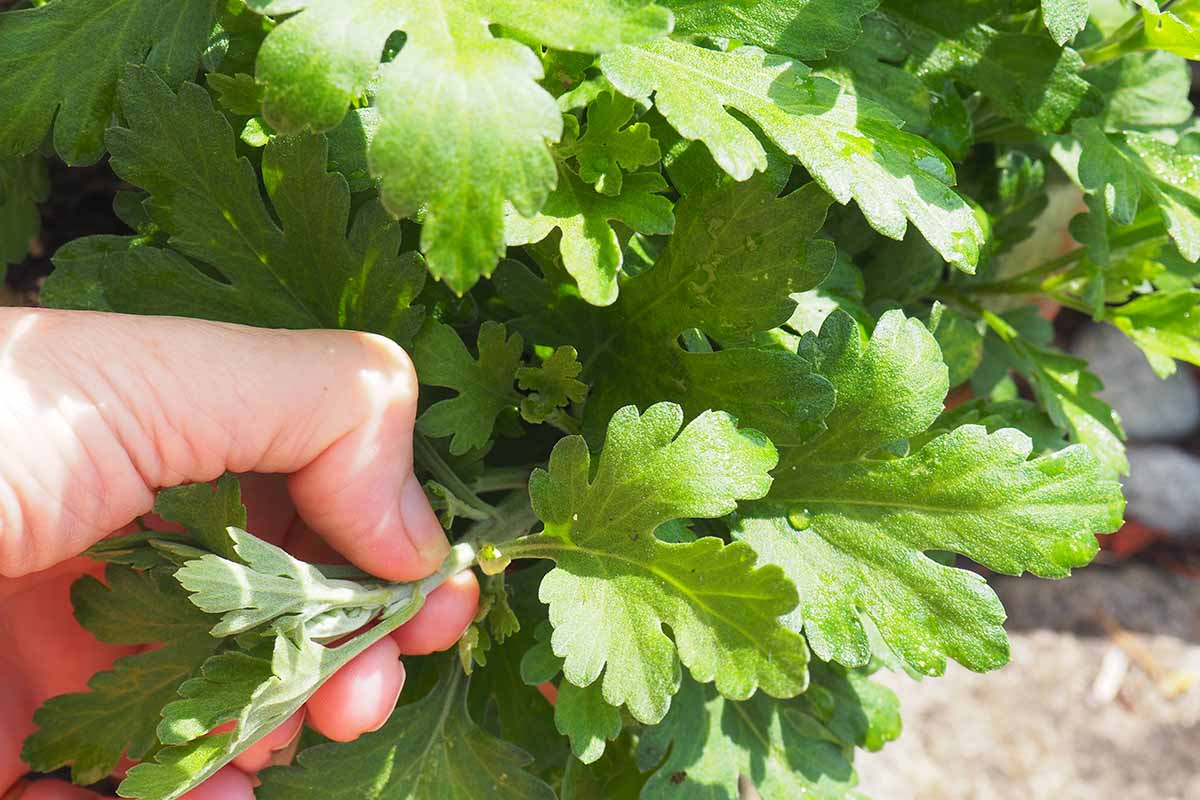
For spray varieties, pinch out the large apical, or terminal, buds but leave the lateral buds in place.
For single bloom varieties, the process is reversed – pinch out the lateral buds and allow apical buds to remain.
Apical/terminal buds grow at the top of stems, or the apex. Lateral buds form lower on the stem at leaf nodes.
Pinch again three weeks later to finish disbudding.
Or you can go the fast route and get good results by simply shearing back plants by one-third to one-half.
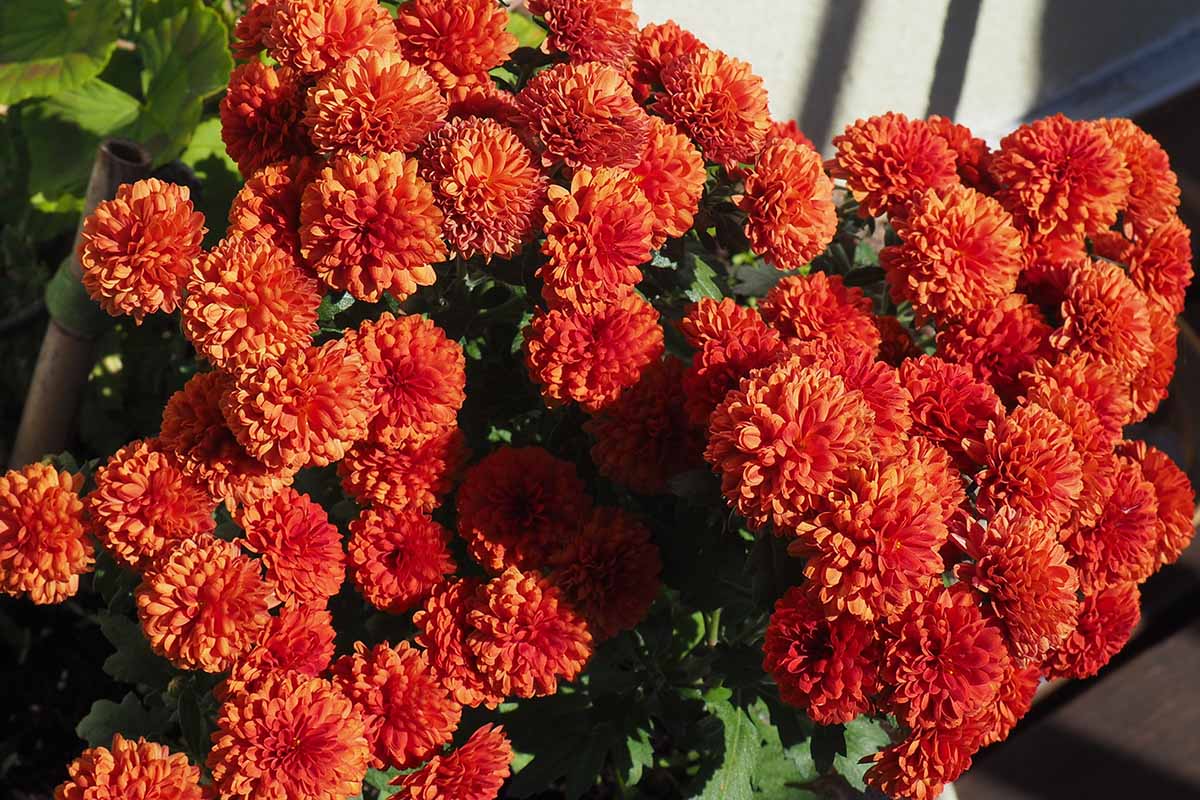
For container growth, choose pots and planters with drainage holes. To keep water moving freely, I like to add a two-inch layer of drainage materials, like broken pottery or pebbles, over the holes.
Fill containers to two inches from the rim with humus-rich, fertile soil.
If needed to enrich the soil, mix in one or two parts compost or well-rotted manure with two to three parts of soil.
Add in one part of grit to three parts of soil to improve drainage, if needed.
Mix in one or two tablespoons of bone meal for fast root growth.
Set plants in place at the same depth as in their nursery containers.
Backfill and firm the soil gently.
Water lightly but deeply to settle plants and maintain slightly moist soil throughout the growing season.
Pinch as outlined above.
Growing Tips
To get the most from your hardy mums, keep the following in mind:
- Ensure the final pinching of plants is done by mid-July – after this time, you risk losing tender buds to a hard frost.
- Mums like moist soil but need excellent drainage. They’re not overly prone to crown or root rot, but it can occur in wet soil.
- If plants are becoming leggy, move to a full sun location for tight, dense growth.
Hardy mums are easily cultivated, but they are heavy feeders. Let’s look at their care regime next.
Pruning and Maintenance
Feed established chrysanthemums in spring, about four weeks after planting or after new growth appears, feeding once again when the first flush of flowers open.
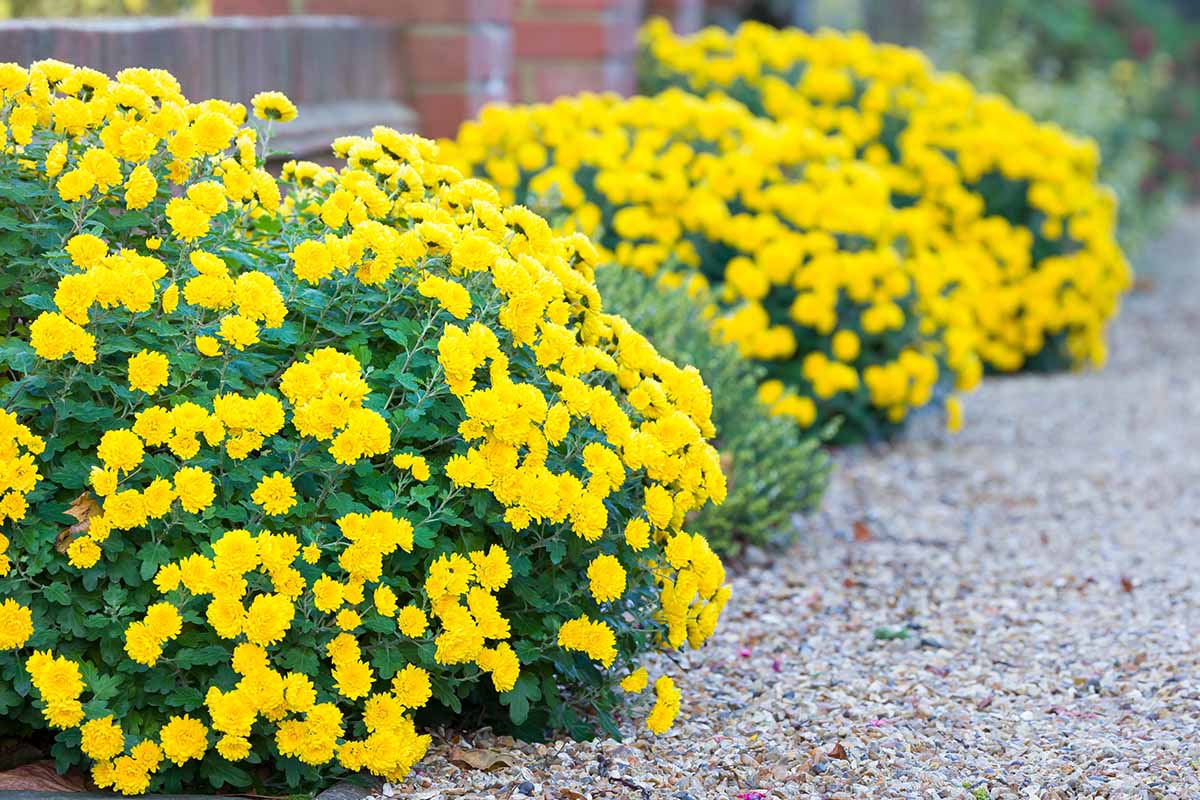
Feed with a two-inch layer of compost or well-rotted manure worked into the soil to side dress bedding and container plants.
Or, granular slow-release pellets with a balanced formula like 10-10-10 NPK can be applied in spring and again in midsummer.
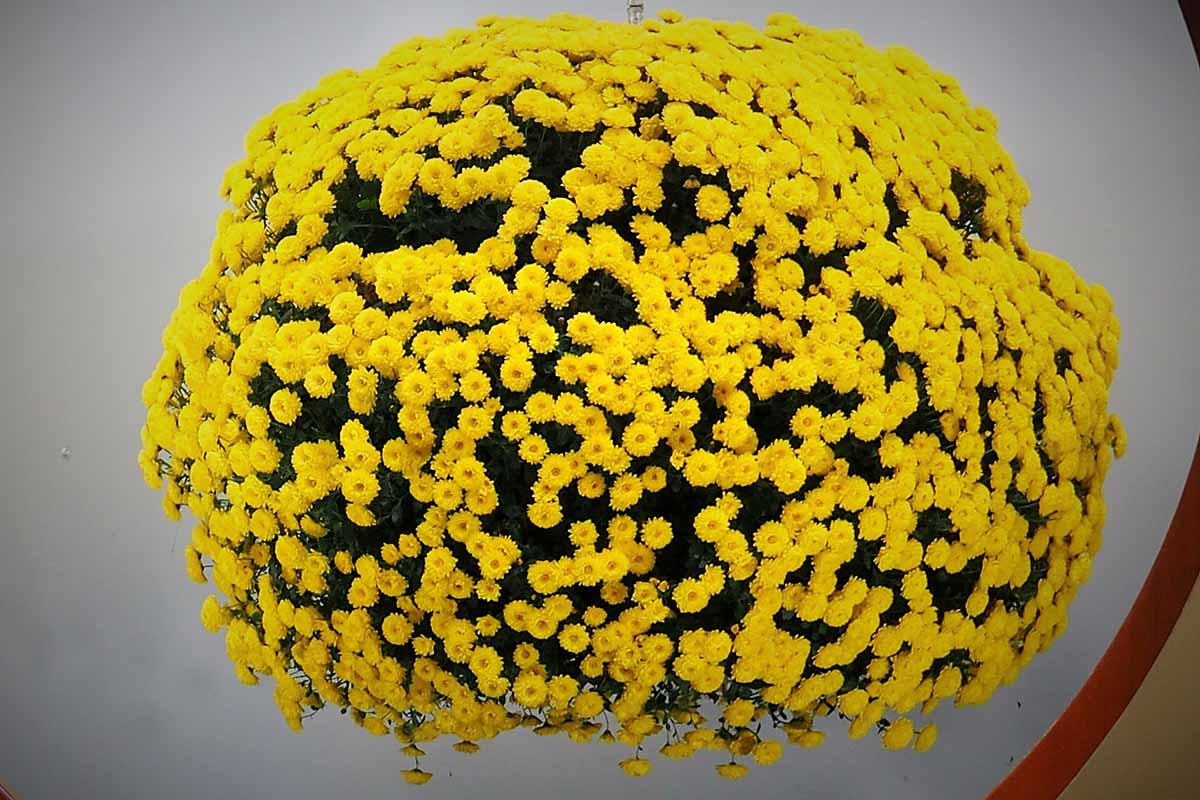
To help keep their shallow roots cool and moist, add a two- to four-inch layer of mulch over the root zone in summer, keeping mulch materials an inch or two away from the crown.
After flowering is finished for the year, cut back plants to six inches. Clean beds and dispose of leaves and decaying plant matter.
Although mums are cold hardy, they have shallow roots and benefit from a winter mulch to protect them from extreme temperatures and freeze/thaw cycles.
Add a four- to six-inch layer of lofty mulch over the root zone, using materials such as shredded bark or straw. Avoid using materials in winter that trap and hold surface water, like leaf mold, which can freeze and heave the roots.
For all the details on cold weather care, read our guide on how to winterize hardy garden mums.
In spring, clean beds again and remove winter mulches after new growth is two to four inches tall.
Chrysanthemum Cultivars to Select
There’s no shortage of gorgeous chrysanthemum varieties for the garden! Here are a few popular options to get started with:
Beverly Bronze
Highly showy, the decorative ‘Beverly Bronze’ has tight, semi-double to double flowers resplendent in shimmering autumn shades of bronze and orange.
Plants are compact and densely branched, forming mounds up to 16 inches tall and 12 inches wide.
A beautiful choice for borders, edging, containers, and window boxes or for tabletop centerpieces and cut flowers. Hardy in Zones 4 to 9.
Plants in grower’s pots from Expert Gardener are available at Walmart.
Coral Daisy
An exceptional performer, Mammoth™ ‘Coral Daisy’ is laden with semi-double, daisy-like flowers of soft coral to lilac pink with lemon yellow disc centers.
Forming dense, tight mounds, ‘Coral Daisy’ grows 24 to 36 inches high and spreads up to 48 inches – simply magnificent for a sea of pink when grouped or massed in beds, edging, or patio planters.
Mammoth™ chrysanthemum varieties require no pinching or pruning. Extra cold tolerant, they’re hardy in Zones 3 to 9.
You can find plants available at Burpee.
Matchsticks
For sparkling brilliance in the late garden, ‘Matchsticks’ is a beautiful spoon class bicolor, featuring open-ended, quill-like petals of warm golden amber tipped in crimson.
Plants are compact and bushy, growing 12 to 24 inches tall and wide with a profusion of flowers from late summer to late fall.
A superb selection for massing or groups in beds, borders, planters, and window boxes, this variety is hardy in Zones 5 to 9.
‘Matchsticks’ is available in containers from Burpee.
Red Daisy
A hardy and dense plant, the decorative Mammoth™ ‘Red Daisy’ is smothered in eye-popping, cerise red, semi-double flowers with yellow centers from late summer into fall.
Forming tight mounds up to 36 inches tall and 36 to 48 inches wide, ‘Red Daisy’ is an absolute showstopper when massed into beds, borders, edging, foundations, and large patio planters. Hardy in Zones 3 to 9.
‘Red Daisy’ plants are available at Nature Hills.
Managing Pests and Disease
Mums are deer and rodent resistant and generally trouble-free, but there are a couple of pests and several fungal problems to watch for.
Pests
A variety of insects may target your mums – and you can read more about the most common chrysanthemum pests in our guide.
Aphids
Aphids are small green, brown, or black sapsuckers that can cause problems like distorted or stunted growth and even plant collapse.
Use a strong spray of water from the garden hose to dislodge aphids from stems and the underside of leaves, repeating in a few days if necessary.
Natural predators like ladybugs and predatory wasps also provide good aphid control.
You can learn more about how to deal with aphids in our guide.
Leaf Miners
Leaf miners are the larvae of small flies which hatch from eggs laid on the underside of leaves, creating pale trails as they tunnel through the leaf’s interior.
Handpick and destroy infected leaves, including any that have fallen to the ground.
See our guide to controlling leaf miners for more information.
Spider Mites
Spider mites are tiny brown to rust-colored sapsuckers that show up in hot, dry weather.
Spray with water as for aphids, or use an insecticidal soap with natural ingredients like neem oil for large infestations.
Neem oil concentrate is available from Arbico Organics.
Learn more about spider mites here.
Disease
In addition, there are a variety of fungal diseases that can affect your chrysanthemums.
Fusarium Wilt
Fusarium wilt, caused by Fusarium oxysporum f. sp. chrysanthemi, is a fungal disease that attacks the vascular system of plants, causing stunted growth and wilting leaves that turn yellow and then brown.
To prevent the spread of wilt, cut away infected plant parts and dispose of them. Be sure to clean tools and sterilize them after touching infected plants.
Treatment with a fungicide may be needed, which you can read about in our guide on how to control fusarium wilt in chrysanthemums.
Leaf Spot
Several different species of soilborne fungi – Septoria chrysanthemi, S. chrysanthemella, and Cercospora chrysanthemi – can cause leaf spot issues.
Symptoms typically appear as small yellow spots that darken to black as they grow, causing leaves to wither and drop prematurely.
Handpick and destroy infected leaves and ensure the soil surface is kept free of garden debris.
Add a two-inch layer of mulch such as shredded bark or straw to help prevent spores from reaching the lower leaves.
And avoid overhead watering to prevent splashing spores from the soil onto leaves and stems.
Powdery Mildew
Powdery mildew is caused by another fungus, Erysiphe cichoracearum. This disease can cover plants in a pale gray powdery coating that causes leaf and stem collapse.
Remove all diseased material from plants and the soil surface, ensure adequate air circulation, and allow the top two inches of soil to dry before watering again.
Learn more about dealing with powdery mildew in chrysanthemums here.
Rust
Rust is another fungal disease, caused by Puccinia chrysanthemi.
It creates pale spots on the topside of leaves with powdery rust-colored growths directly underneath, weakening plants and causing poor bloom set.
Remove infected leaves promptly and clean debris from beds regularly. Ensure plants have good air circulation and avoid overhead watering.
If rust is a common problem in your garden, look for rust-resistant varieties such as ‘Achievement,’ ‘Mandalay,’ and ‘Orange Bowl.’
Best Uses of Chrysanthemums
Chrysanthemums are fabulous for fall decorating indoors and in the garden as well.
Use compact or dwarf mums for fall holidays in tabletop centerpieces, cornucopia or harvest displays, and cut flower arrangements.
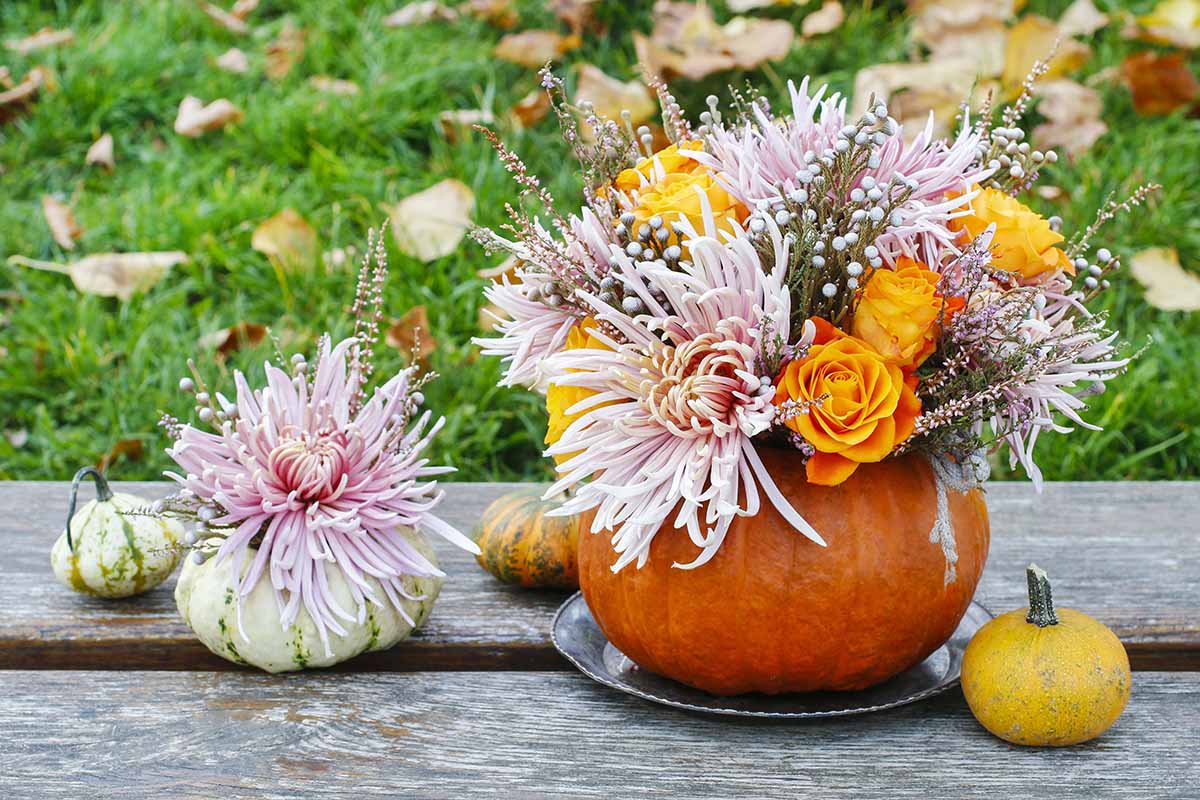
Outdoors, small varieties shine when mixed with other fall flowers like asters and echinacea or massed for borders, edging, flanking pathways and sidewalks, patio pots, and window boxes.
Use larger, mounding chrysanthemums as vibrant standalone specimens or grouped for a bold, colorful impact in beds, edging, foundations, and large planters or urns.
Quick Reference Growing Guide
| Plant Type: | Herbaceous flowering perennial | Flower/Foliage Color: | Burgundy, chocolate, mauve, maroon, orange, peach, pink, purple, scarlet, white, yellow, bicolor/green |
| Native to: | Northeastern Europe and Asia | Maintenance: | Low |
| Hardiness (USDA Zones): | 4-9 (many hardy to Zone 3) | Tolerance: | Deer, rabbits, squirrels |
| Bloom Time: | Late summer, fall | Soil Type: | Humus-rich and loamy |
| Exposure: | Full sun to light shade | Soil pH: | 6.5-7.0 |
| Time to Maturity: | 6-9 months (stem and root cuttings) | Soil Drainage: | Well-draining |
| Spacing: | 12-18 inches | Attracts: | Bees, other pollinators |
| Planting Depth: | Crown just below soil | Uses: | Beds, borders, centerpieces and cut flowers, containers, edging |
| Height: | 12-36 inches, depending on variety | Order: | Asterales |
| Spread: | 12-48 inches, depending on variety | Family: | Asteraceae |
| Water Needs: | Moderate | Genus: | Chrysanthemum |
| Common Pests and Diseases: | Aphids, leaf miners, spider mites; fusarium wilt, leaf spot, powdery mildew, rust | Species: | Grandiflora, indicum, morifolium, rubellum, and hybrids |
Late-Season Sensations
Whatever type of hardy mums you grow and enjoy, they make a sensational splash of late color to finish up the growing season.
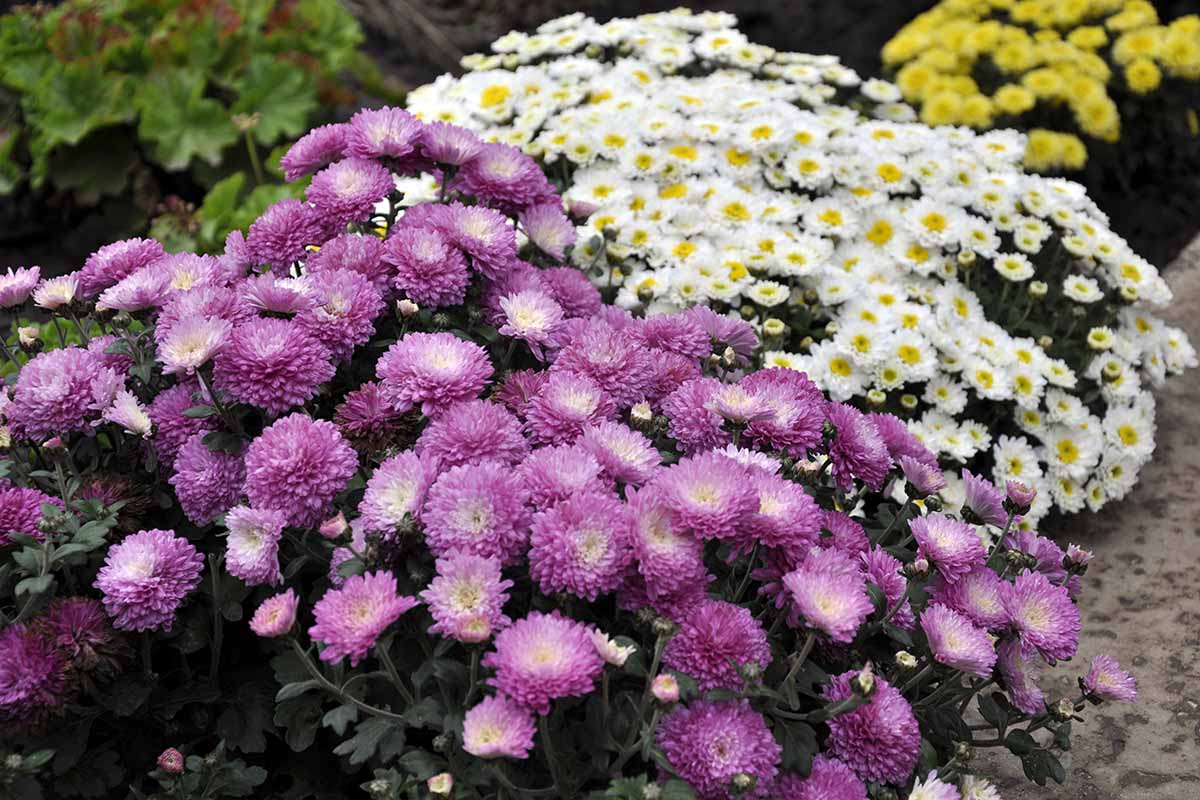
Give them plenty of sunshine and regular water in soil with excellent drainage then pinch vigorously for plants densely laden with showy flowers.
What’s your favorite setting for hardy garden mums? Tell us about it in the comments section below.
And for more chrysanthemum know-how, add these articles to your reading list next:
